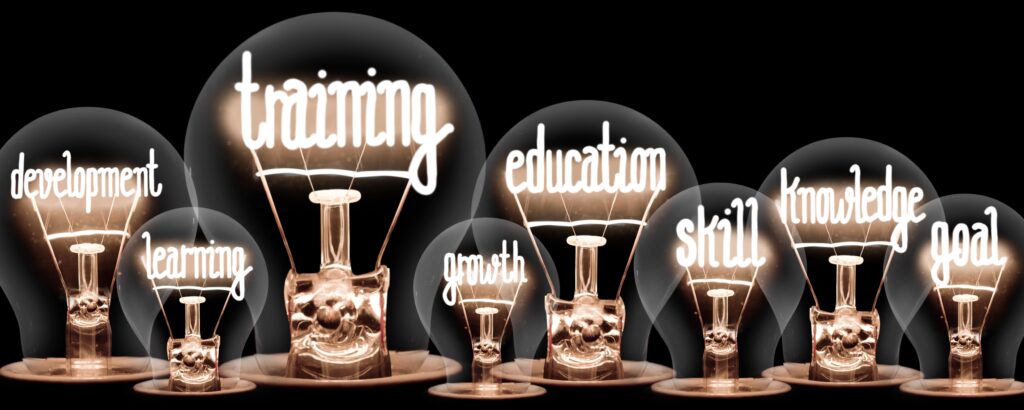In this Article...quick links
It’s not sufficient these days to simply be a knowledge leader in your field, particularly if you want to advance your career and move up the management ladder. You also have to be able to effectively communicate that knowledge together with your ideas and recommendations to others in a way that is clear, interesting and informative. So, it’s highly likely that you will need to improve your public speaking. Why? Because really effective presentation and public speaking skills are now considered a must-have for career progression.
Regardless of the stage that you are at in your career – a graduate wanting to highlight the work you’ve done on a project, a junior exec wanting to become a manager, or anyone seeking a promotion or a pay rise, – being able to communicate the value that you bring to your organisation is an important skill that needs to be developed. Without this skill, it’s highly unlikely that you will progress beyond middle management.
Many of our posts are aimed at experienced presenters wanting to hone their skills. However, in this blog, we are focussing on those just starting out in their careers. We’ll take you through some key tips that you can apply to a variety of situations where you need to communicate information and give you some expert advice that will help you to develop a skill base on which you can build.
Why is it important to be a good communicator?
Being able to communicate your ideas effectively will give you self-confidence, and more importantly, instil confidence in others in your abilities – be they staff, peers, clients, senior management or stakeholders. It is also a skill, importantly, which helps to avoid miscommunication!
Although it’s a skill usually developed in the business environment, learning to become an effective communicator is also a great life skill, and can improve relationships, help you to navigate new situations and develop new contacts.
It’s important to remember that communication is a two-way street. To be an effective communicator you also have to be an effective listener. And listening, in this context, is not just about hearing, but also being mindful of other people’s non-verbal cues such as body language, attention and engagement.
Improving public speaking – starting with the basics
Whether it’s as simple as a quick one-to-one catch-up, a status meeting with a few colleagues, or a more formal situation involving a larger group and possibly slides, there are two key points to remember for every presentation situation.
- It’s all about the audience, not you. This may sound harsh but the reality is you are only there because of the audience. So everything you say and do should be with them front of mind.
- Make sure you are prepared. If you are underprepared this will become evident immediately and may tarnish your reputation. So let’s discuss these aspects in more detail.
Understanding the needs of the audience
When preparing for any meeting or presentation, always start with the audience in mind so that you can tailor your content to their needs. Also, be very clear in your mind about what you want to achieve from the meeting or presentation and make sure that everything you say is geared towards achieving this goal(s).
How to kick things off
Once you and the audience are on the same page, start the meeting or presentation by briefly outlining the context for the discussion and then provide a clear objective or purpose for the audience. The purpose should cover the subject matter, why it’s relevant and important to the audience, and what action you are seeking as a result.
I can’t tell you how many meetings I have sat through during my career where absolutely nothing was achieved. What a waste of time! And almost always it was because there was no clear objective, purpose or goal for the meeting set out at the start.
Managing the flow
Having outlined why everyone is there, next you should provide an agenda for the audience that chunks up what you’re going to be covering. This will make your content easier to digest and follow. Not only that but the agenda provides the structure and flow for the presentation – so everyone knows where you’re going.
During the flow, be sure you check-in with the audience along the way to see if they have any questions or require further detail. Also, ensure each section, or chunk, has some kind of conclusion or summary before moving on to the next section.
Finessing the close
The end of your presentation is as important as the start. So make sure you finish with a strong close that wraps up the agreed actions, timelines and responsibilities.
These simple but effective guidelines are applicable to any meeting format, but there are extra things you need to know if you are preparing to deliver a presentation in a more formal setting.
Preparing for a more formal presentation
Start with the audience in mind
Once again, it’s important to start with the audience in mind before you even begin to think about what you might say.
Who are you presenting to, what is their level of seniority and interest in the subject, and why have they invited you to present?
If you don’t have much information about the audience, do whatever you can to get as much detail about them as you can. You might ask colleagues about them, Google them, or even ask them themselves.
The key point here, and one that will really improve your public speaking, is that the more you know who your audience is going to be, the more you can tailor what you’re going to cover so it’s going to be as relevant and interesting for them as possible.
Take your audience on a journey
When thinking about preparing what you want to say during your presentation, DON’T start by simply bashing out a bunch of slides. In fact, that’s the worst thing you can do.
Instead, take a more strategic approach by writing down, or tapping out, a short outline of the journey you want to take your audience on. So again, think about the overall objective you want to achieve.
Now chunk up your content into sections, or if you like – chapters of your story. Make sure there are no more than 3 to 5 of these; any more than that and you’ll be in danger of disengaging your audience at best, or losing them at worst. Each section/chapter should have a punchy headline and a clear and impactful takeaway point at the end that moves the audience towards your final objective. If it doesn’t, rework it until it does.
Only now, that you’ve got the journey or narrative, sorted should you flesh out your presentation by adding your content, or body, to the presentation. Critically, everything you include needs to be both concise and compelling. So don’t overwhelm the audience with irrelevant data or information. Instead, make sure it adds value and helps to support your message in some way.
Using slideware
If you’re using slides, here’s a few hints when it comes to creating them:
- Less is definitely more. Before sharing the purpose of the presentation try to start with a startling statistic, a meaningful quote, or impactful image to grab the audiences’ attention.
- If you have bullet points and text on your slides follow the 5×5 rule-of-thumb i.e. no more than about 5 bullet points on a slide and no more than about 5 words per bullet point. This should be enough to keep you on track (remember, your slides are there to support you, not tell the story, that’s your job!), whilst not overwhelming and disengaging the audience.
- If you’re using graphs, make sure the axis labels and legends are easy to read. If they’re not your charts will be meaningless.
- Make use of graphics and iconography to help bring your information, to life. They can be great for depicting timelines, processes, structures and interrelated items within a list.
For more advanced tips on creating impactful slides check out our expert advice here:
- How To Create Engaging & Memorable PowerPoint Slides for Your Presentation
- How to Use and Why It’s OK To Read From Your Slides
- The Best Data Visualisation Methods for Your Next Presentation
Be tech-prepped
The last thing you want on the day is to be caught out with tech. Make sure you’re familiar with the room you’ll be in for the presentation and practise. Otherwise, consider arriving at least an hour early so you have time to set up and test that the system is working. Nobody likes hanging about whilst a presenter tries to figure out leads, plugs, remotes and the rest.
You should also consider preparing a paper handout in case the tech fails on the day. This is also a great bonus way for people to take down annotations or notes.
Position yourself for maximum impact
Think about where to stand depending on where you want the focus of attention to be. When you start and finish the audience’s focus should be on you, so stand at the head of the table. When you want the focus split between you and the slides, stand just to one side of the screen. If you want the focus to be solely on the information on the slide then move further to one side of the room.
Be aware of your body language
Be enthusiastic but not OTT. That means being aware of your own body language. Don’t wave your arms around or make frantic movements. Also, avoid pacing or rocking on the spot. And it goes without saying that you shouldn’t fiddle with your clothing, hair or face. Try to find a relaxed, neutral position that makes you feel, and appear, confident. Similarly, make sure you don’t give off any negative, non-verbal cues, such as eye-rolling, raised eyebrows or folded arms. Channel a yoga mindset!
Anticipate questions in advance
Anticipate difficult questions and have as many answers as you can prepared in advance. If you don’t know the answer, say so, but provide a timeframe for when you will respond with the information.
In addition, don’t forget to check-in with the audience now and again, and be on the look out for any non-verbal cues that might indicate that someone has a query or concern. If you see this, pause and check in with that person, or group of people.
Remember, at the end of the day, the presentation is all about them.
Stick to time
If you’ve practised sufficiently this shouldn’t be an issue. But if you feel as though you are going to run over then stick to just the key points and make sure you land your closing sentence. This should reflect the original objective or purpose of the presentation. Running overtime is a prime rookie mistake.
Whilst there is more to think about with more formal presentations, it’s important to remain true to yourself. In other words, don’t try to be someone you’re not.
11 Top tips for improving public speaking skills
Given that effective communication is such a critical skill in both our professional and personal lives we’ve included some extra tips below.
- Practice listening. It’s important to hear what is actually being said as opposed to what you perceive is being said. Listen well, make notes and ask questions if you don’t understand.
- Speak slowly and clearly. This will not only make you feel more relaxed and confident, but it will also make you appear more confident. Slowing down and including plenty of pauses will also give the audience time to keep up with what you’re saying and digest the information you’re sharing. If you speak too quickly it’s likely the audience won’t keep up and you’ll lose their interest. Speaking slowly also helps to ensure that you don’t forget or miss out on vital information.
- Vary your tone of voice. Think about using your voice to bring your story or message to life. A good tip is to use a tone that is reflective of the content e.g. more upbeat and animated when the content is positive, and more downbeat and controlled when the content is either negative or perhaps more complex.
- Embrace the pause. Pausing is one of the most important and effective communication skills that you can learn. Pause before answering a question to make sure you fully understand it and demonstrate to the questioner that you are giving it careful consideration. Pause before making an important point to ensure the focus is on the key message. Pause before moving on to the next section/chapter of your presentation so that the key takeaway point can be fully digested. Pause when you change position. When in doubt, pause!
- Smile. I don’t know about you, but my resting face can sometimes be a little fierce, so make sure you smile. It makes you feel good because it releases endorphins. It’s also contagious and makes other people feel good too. It communicates understanding, enthusiasm and creates an all-round good vibe.
- Prepare, prepare, prepare. This advice about improving public speaking never goes away, no matter how many times you will present over the course of your career. Preparation and practise are key to success on the day.
- Take every opportunity to present. Presenting to small groups of people is a good way to gain experience and far less nerve-wracking than standing up in a room of fifty+ people. Volunteer to present to your team and small groups when the opportunity arises to gain valuable experience and help boost your confidence. We aren’t born good presenters, it’s a skill that has to be practised and developed.
- Seek feedback. You don’t want to appear as if you are fishing for compliments but it is useful to get unbiased feedback from a more senior or experienced presenter. Perhaps ask someone in advance if they would be prepared to offer feedback as a learning tool. If your company has a mentoring program in place then make the most of this valuable resource.
- Watch and learn. Right from the get-go you are likely to be in situations where you are a part of an audience. Study the techniques of more experienced presenters around you and make notes about what makes them a compelling and effective communicator. The best presenters appear as though they are having a conversation with the audience. Check out the highest-rated Ted Talks to watch and learn from some experts.
- Check in with your colleagues regularly to see how they are doing. We’re all busy, but establishing good relationships with those around you is a key component of developing your communication skills. It improves your listening skills and helps you to develop empathy – a highly rated quality in business leaders. You’ll also learn a lot about other parts of the business. So that’s a bonus!i
- Ask for training. If your company has an L&D budget then ask to participate in a high-quality business presentation skills training program. We emphasise the word business here because the group sizes are small, they’ll include one-to-one coaching sessions and the subject matter is tailored specifically to you and the types of presentations you’re involved in. Don’t be tempted by a short day, mass audience public speaking course, unless you’re simply looking to deliver a best man or best woman speech!
Ready to progress in your career?
There’s no doubt effective presentation and public speaking skills are crucial for people starting out in their careers, and for those that want to progress their careers. It’s never too soon to start improving public speaking skills, and indeed, we never stop learning them either!
Check these articles out too to help you build your presentation skills:
- What to do with your hands when presenting
- How to speak with gravitas
- Overcoming stage fright
- Filler words and how to reduce them
If you’d like to improve your presentation skills through training or one-to-one coaching that is tailored to your business, we can help.
For nearly 20 years we have been the Business Presentation Skills Experts, training & coaching thousands of people in global organisations – check out what they say about our programs.
To find out more, click on one of the buttons below:

Belinda is the Co-Founder and Managing Director of SecondNature International. With a determination to drive a paradigm shift in the delivery of presentation skills training both In-Person and Online, she is a strong advocate of a more personal and sustainable presentation skills training methodology.
Belinda believes that people don’t have to change who they are to be the presenter they want to be. So she developed a coaching approach that harnesses people’s unique personality to build their own authentic presentation style and personal brand.
She has helped to transform the presentation skills of people around the world in an A-Z of organisations including Amazon, BBC, Brother, BT, CocaCola, DHL, EE, ESRI, IpsosMORI, Heineken, MARS Inc., Moody’s, Moonpig, Nationwide, Pfizer, Publicis Groupe, Roche, Savills, Triumph and Walmart – to name just a few.






